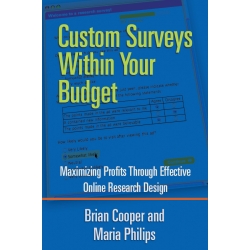Custom Surveys Within Your Budget by Brian Cooper and Maria Phillips
|
"Custom Surveys Within Your Budget by Brian Cooper and Maria Phillips"
Maximizing Profits Through Effective Online Research Design |
|
| Price: | $34.95 |
| Availability: | In Stock |
| Item #: | 1066 |
| Author: | Cooper, B. & Philips, M. |
| Average Rating: | 
|
A Comprehensive Guide for DIY Research
by Brian Cooper and Maria Philips
Researchers and marketers who use this book will find many different benefits. A marketer may ask how to properly display a scale on a screen. Others will ask about the technology survey engines being used today. Professional researchers might be challenged by the impact of using colors in scales in different countries. Most readers will benefit by searching for a specific research topic to address the matter at hand. A critical feature is an evaluation of the various survey tools available in the market.
Custom Surveys acts as a comprehensive guide to cost effectively managing a survey and covers everything from the evaluation of a research program to the actual output and analytics of the research. It can be used as a reference for specific market research needs as well as an instructional tool to educate readers interested in doing market research. Marketers or researchers who read through this entire book will become familiar with the requirements of conducting research on a minimal budget.
(212 pp., paperback, ISBN 978-0-9819869-3-7; May 2010)
Table of Contents
Preface
Chapter 1 The Background of Internet Research
New developments in Internet research
Comparisons with phone and mail survey technology
Chapter 2 How to Determine if Your Study Should be Conducted Online
Business needs
Sound methodology
Technology efficiency
Cost efficiency
Types of studies conducted online
Chapter 3 Setting Up Your Online Survey
Review the objectives of your study
Determine who will conduct your survey (for non-researchers)
Set up the analysis
Determine the survey tool
Design the questionnaire
Type of questionnaire • Create the foundation of your
questionnaire • Use a word-processing document to build your questionnaire • Questionnaire flow: Broad to specific • Now, compose a question • Should you add color? • Building specific question types
Establish survey programming rules
Field the survey
Upload the respondent list • Remove duplicate records
Sampling plan
Acquire potential respondents
Response rate versus completion rate
Bouncebacks • Calculating response rates with bouncebacks
• Completion rates
Common incentives
Close the survey
Conduct the analysis
Reporting the data
Chapter 4 Selecting a Survey Tool
Web-hosted versus server-based Methodology
Technical considerations
Survey Types • Questionnaire design with templates •
Graphics capabilities • Streaming video capabilities • Skip logic
• Auto-fill or piping • Required questions • Error messages • Help link • Pause or bookmark • Back button • Survey integration • Visual customization • Contact record management • List management
Survey invitations
Tabs • Filters • Scorecard results view
Analytical toolsets
Chapter 5 Common Internet Survey Issues
The time to complete a survey
Number of questions in an online survey
Type of questions in a survey
Respondent target base (demographics)
Survey attrition
The effect of visual displays
Dependence on survey type
spam
Sidebar: CAN-SPAM Act of 2003
Disclose the sponsor and sender of the survey
The “From” address • Email “spoofing” and why to avoid it • ISPs and blacklists • Dealing with the customer’s company • Dealing with irate customers or respondents who have
already opted-out
Sidebar: Common words or phrases that get caught in SPAM filters
Mixed mode methodology
Online population: cultural and behavioral factors
Differences in interviewing environment • Programming rules
• Survey administration • Visual cues
Changing survey modality in successive waves
Evaluating trade-offs when changing survey
modalities
Length of time for conducting a parallel test • Analyzing data for parallel test • Adjusting the data for the parallel test • Using parallel tests to switch vendors • Updating the survey while in the field
Survey frequency fatigue
Fatigue and customer lists • Setting the frequency fatigue rule • Frequency fatigue and complete versus incomplete surveys
Panel-supplied respondents
Frequency fatigue and types of surveys
Incentives affect frequency fatigue • Number of days for frequency fatigue rules
Random sampling error and non-sampling error
Survey response error • Survey programming error •
Data processing error
Chapter 6 Designing Survey Invitations
Developments in survey invitations
Crafting an email invitation
Email invitation examples
Text-based survey invitations • HMTL-based survey invitations • Pop-up/overlay-based survey invitations • Other types of survey invitations
Chapter 7 Sample Sources and Response Rates
Third-party provided sample
Overview of panels
Pricing the panels • Panel incidence • Panel recruitment approaches • Contacting a panel provider • Compensating panelists • Personally identifiable information from panel providers
Sidebar: ESOMAR’s 25 Panel Questions
Professional survey takers
Sidebar: Beyond Professional Survey Takers:
Persuasion from the Sponsoring Company
Custom panels
What are the recruitment methods for the custom panel? • What maintenance methods are provided? • Custom panel incentives • Survey frequency for custom panels • Response rates
River sample
Chapter 8 Questionnaire Layout and General Formatting Requirements
Structure: From general to specific questions
First Step: Instructions at the beginning of a survey
Second Step: Body of the survey
Third Step: Finalizing the survey
Consumer-oriented surveys • Business-oriented surveys
Survey formatting
Using a banner to brand a survey • Using color elements • Background colors • Text styles • Common font styles • Page breaks
Referencing outside information
Chapter 9 Survey Programming Rules
Autofills
Branching rules
Branching rules with data fill
Order rotations
Chapter 10 Single-Punch and Multi-Punch Questions
Creating a question
Single-punch guidelines
Multi-punch guidelines
Long answer lists
Chapter 11 Using Grid/Matrix Questions
Advantage of grid questions in a web survey
Listing ratings and attributes in columns and rows
Length of attribute lists
Grid: Scale questions • Grid: Single-punch questions • Grid: Check lists
Rotation of the attribute list in grids
Chapter 12 Open-Ended Questions
Follow-up to scale questions
Obtain respondent feedback in their own words
Analysis of open ends
Chapter 13 Using Scales in Online Internet Research
Types of scales
Categorical scales • Ordinal scales • Interval scales
Scale considerations
Balanced, unbalanced, and anchored scales • Scale length (4-, 5-, 6-point or more)
Visual layout
Scale consistency • Cultural influences • Historical approaches • Technology limitations • Intervals between points on a scale • Shading, colors, lines, visual cues, smiley faces • Displaying values for each point • Displaying anchors and mid-points
Horizontal versus vertical orientation
Validation questions
Finding the preferred approach
Chapter 14 Use of Multimedia in Online Research
Risks and concerns
Security • Image/video formats • Download times
Implementing applications into research
Advertising testing • Concept testing • Tracking • Package design • Programming content evaluation • Measurement of brand variants • Product placement/retail display
Chapter 15 Online Qualitative Tools
Advantages and disadvantages
Using forums
Important functions of online qualitative tools
The “Observer” view: A patent dispute
Costs to conduct online message boards
Costs to conduct online focus groups
Video diaries and one-on-one interviews
Tools vendors
Chapter 16 Privacy and Security
Respondent Security
Company Security
Preventing respondents from gaming the survey • Protecting confidentiality • Ensuring high-quality data with unique survey links
Chapter 17 Research with Children
Appendix Online Survey Research Directory
Introductory survey tools
Mid-tier survey tools
Enterprise scalability
Alternative qualitative support tools
Video streaming technology
Full-service vendors
Index
Also available for Amazon Kindle readers
Your Review: Note: HTML is not translated!
Rating: Bad Good
Enter the code in the box below:








